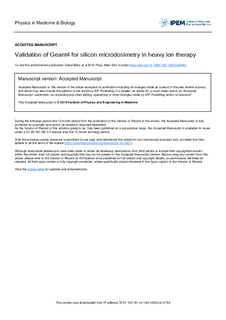| dc.contributor.author | Bolst, David | |
| dc.contributor.author | Gautelli, Susanna | |
| dc.contributor.author | Tran, Linh T. | |
| dc.contributor.author | Davis, Jeremy | |
| dc.contributor.author | Chartier, Lachlan | |
| dc.contributor.author | Prokopovich, Dale A. | |
| dc.contributor.author | Pogossov, Alex | |
| dc.contributor.author | Reinhard, Mark I. | |
| dc.contributor.author | Petasecca, Marco | |
| dc.contributor.author | Lerch, Michael L.F. | |
| dc.contributor.author | Matsufuji, Naruhiro | |
| dc.contributor.author | Povoli, Marco | |
| dc.contributor.author | Kok, Angela | |
| dc.contributor.author | Summanwar, Anand | |
| dc.contributor.author | Jackson, Michael | |
| dc.contributor.author | Rosenfeld, Anatoly B. | |
| dc.date.accessioned | 2020-01-15T09:53:53Z | |
| dc.date.available | 2020-01-15T09:53:53Z | |
| dc.date.created | 2020-01-14T09:09:45Z | |
| dc.date.issued | 2019 | |
| dc.identifier.issn | 0031-9155 | |
| dc.identifier.uri | http://hdl.handle.net/11250/2636364 | |
| dc.description.abstract | Microdosimetry is a particularly powerful method to estimate the relative biological effectiveness (RBE) of any mixed radiation field. This is particularly convenient for therapeutic heavy ion therapy (HIT) beams, referring to ions larger than protons, where the RBE of the beam can vary significantly along the Bragg curve. Additionally, due to the sharp dose gradients at the end of the Bragg peak (BP), or spread out BP, to make accurate measurements and estimations of the biological properties of a beam a high spatial resolution is required, less than a millimetre. This requirement makes silicon microdosimetry particularly attractive due to the thicknesses of the sensitive volumes commonly being ∼10 µm or less. Monte Carlo (MC) codes are widely used to study the complex mixed HIT radiation field as well as to model the response of novel microdosimeter detectors when irradiated with HIT beams. Therefore it is essential to validate MC codes against experimental measurements. This work compares measurements performed with a silicon microdosimeter in monoenergetic 12C , 14N and 16O ion beams of therapeutic energies, against simulation results calculated with the Geant4 toolkit. Experimental and simulation results were compared in terms of microdosimetric spectra (dose lineal energy, d(y)), the dose mean lineal energy, yD and the RBE10, as estimated by the microdosimetric kinetic model (MKM). Overall Geant4 showed reasonable agreement with experimental measurements. Before the distal edge of the BP, simulation and experiment agreed within ∼10% for yD and ∼2% for RBE10. Downstream of the BP less agreement was observed between simulation and experiment, particularly for the 12C and 16O beams. Simulation results downstream of the BP had lower values of yD and RBE10 compared to the experiment due to a higher contribution from lighter fragments compared to heavier fragments. | nb_NO |
| dc.language.iso | eng | nb_NO |
| dc.publisher | IOP | nb_NO |
| dc.rights | Attribution-NonCommercial-NoDerivatives 4.0 Internasjonal | * |
| dc.rights.uri | http://creativecommons.org/licenses/by-nc-nd/4.0/deed.no | * |
| dc.subject | Microdosimetry | nb_NO |
| dc.subject | Radiation | nb_NO |
| dc.subject | Ion therapy beams | nb_NO |
| dc.title | Validation of Geant4 for silicon microdosimetry in heavy ion therapy | nb_NO |
| dc.type | Journal article | nb_NO |
| dc.type | Peer reviewed | nb_NO |
| dc.description.version | acceptedVersion | nb_NO |
| dc.rights.holder | As the Version of Record of this article is going to be/has been published on a subscription basis, this Accepted Manuscript will be available for reuse under a CC BY-NC-ND 3.0 licence after a 12 month embargo period. Although reasonable endeavours have been taken to obtain all necessary permissions from third parties to include their copyrighted content within this article, their full citation and copyright line may not be present in this Accepted Manuscript version. Before using any content from this article, please refer to the Version of Record on IOPscience once published for full citation and copyright details, as permission may be required. All third party content is fully copyright protected, unless specifically stated otherwise in the figure caption of the Version of Record. | nb_NO |
| dc.source.journal | Physics in Medicine and Biology | nb_NO |
| dc.identifier.doi | https://doi.org/10.1088/1361-6560/ab586a | |
| dc.identifier.cristin | 1771979 | |
| dc.relation.project | Norges forskningsråd: 219991 | nb_NO |
| cristin.unitcode | 7401,90,31,0 | |
| cristin.unitname | Microsystems and Nanotechnology | |
| cristin.ispublished | true | |
| cristin.fulltext | postprint | |
| cristin.qualitycode | 1 | |

